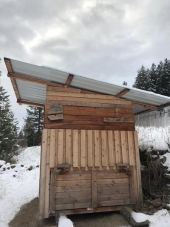





 19
19





Striving to grow things as naturally, simply, and cheaply as possible! 
My YouTube channel
 2
2







 2
2





Striving to grow things as naturally, simply, and cheaply as possible! 
My YouTube channel
 11
11





 7
7




 I also find they help bring in fungi and you probably could inoculate a fresh log and put it on the north side of the bed to keep it in some shade.
I also find they help bring in fungi and you probably could inoculate a fresh log and put it on the north side of the bed to keep it in some shade.
Cultivate abundance for people, plants and wildlife - Growing with Nature



 3
3




Kc Simmons wrote:Looks great!
I've done similar things, but I usually fill the trench with small logs/sticks/wood chips. Otherwise my sandy soil tends to gradually fill them back up.
Like you, I haven't built any "traditional" raised beds due to the time, expense, labor; so free and easy are always welcome qualities in my projects


Striving to grow things as naturally, simply, and cheaply as possible! 
My YouTube channel
 2
2




Daron Williams wrote:Nice method Steve! Have you tried adding decent size logs to the trenches? I add logs around all my growing areas and I'm always amazed with the amount of life I find under them.
I had to pull up one the other day to redo the sheet mulching to get rid of some grass and under the log there were lots of centipedes and other critters. Centipedes are great little predators!I also find they help bring in fungi and you probably could inoculate a fresh log and put it on the north side of the bed to keep it in some shade.
If you just added a log to the north side and inoculated it you could potentially get a mushroom harvest and create more habitat for beneficial critters.
Thanks for sharing Steve--I really like it and I think I might copy your method for a couple of my future projects.
Striving to grow things as naturally, simply, and cheaply as possible! 
My YouTube channel
 4
4




Kc Simmons wrote:Looks great!
I've done similar things, but I usually fill the trench with small logs/sticks/wood chips. Otherwise my sandy soil tends to gradually fill them back up.
Like you, I haven't built any "traditional" raised beds due to the time, expense, labor; so free and easy are always welcome qualities in my projects
To lead a tranquil life, mind your own business and work with your hands.
 17
17





Check out the Food Forest Card Game: https://permies.com/wiki/141665/Food-Forest-card-game-English
 2
2




To lead a tranquil life, mind your own business and work with your hands.
 7
7




'What we do now echoes in eternity.' Marcus Aurelius
How Permies Works Dr. Redhawk's Epic Soil Series
 3
3




 4
4




Lif Strand
New Mexico USA
 1
1




Xisca - pics! Dry subtropical Mediterranean - My project
However loud I tell it, this is never a truth, only my experience...
 3
3








Lif Strand wrote:I like this idea very much! I'm wondering what you and others do to prevent gophers and other underground critters from coming in from the bottom and rabbits and other above-ground critters from coming in from the top?

Striving to grow things as naturally, simply, and cheaply as possible! 
My YouTube channel
 3
3




Kc Simmons wrote:Question about the logs/big branches in the garden: do you just leave them on the surface? I like using them for borders in the garden, but I was worried they may wick out moisture in the warmer months. Lately, I've been laying them on the surface to border the beds, then mounding wood chips over them, and wondering if that step is even needed.


Striving to grow things as naturally, simply, and cheaply as possible! 
My YouTube channel
 1
1




Cultivate abundance for people, plants and wildlife - Growing with Nature



 3
3




Steve Thorn wrote:Have you grown any particularly easy to grow and low maintenance varieties?
Cultivate abundance for people, plants and wildlife - Growing with Nature











 5
5




Real funny, Scotty, now beam down my clothes!
 7
7




 5
5




 1
1




Lif Strand wrote:I like this idea very much! I'm wondering what you and others do to prevent gophers and other underground critters from coming in from the bottom and rabbits and other above-ground critters from coming in from the top?
A joyful heart is good medicine.
 3
3




 3
3




steve bossie wrote:...my free beds are made from scavenged logs...
Lif Strand
New Mexico USA
 3
3




Some places need to be wild
 2
2




Check out Redhawk's soil series: https://permies.com/wiki/redhawk-soil
 4
4




$10.00 is a donation. $1,000 is an investment, $1,000,000 is a purchase.
 2
2




John Suavecito wrote:I have read that in the Middle ages, raised beds without wooden sides were a normal way to grow vegetables. Perhaps this was the inspiration for the modern raised beds.
John S
PDX OR
$10.00 is a donation. $1,000 is an investment, $1,000,000 is a purchase.
 4
4




A human being should be able to change a diaper, plan an invasion, butcher a hog, conn a ship, design a building, write a sonnet, balance accounts, build a wall, set a bone, comfort the dying, take orders, give orders, cooperate, act alone, solve equations, analyze a new problem, pitch manure, program a computer, cook a tasty meal, fight efficiently, die gallantly. Specialization is for insects.
-Robert A. Heinlein
 5
5




 1
1




 3
3




Greetings from Brambly Ridge
 3
3




Eric Hanson wrote:Steve,
I just now got around to watching your video. Very nice! Just to satisfy my own curiosity, my understanding is that it not so much a raised bed but a sunken border? Did the soil you dug from the trench get put into the bed to raise the bed up a bit?
Also, is it your plan to help raise the bed up with the decommissioning leaves? I am just curious as I tried—for years—to fill up my raised beds (they had roughly 12” diameter logs as raised edges) with leaf litter.
My understanding is that oak leaves are among the very best leaves to use as compost. For years I raked my neighbor’s lawn where he had 1/2-1acre of pretty thick leaf fall from his nice long row of mature oaks. I would rake and blow the leaves into long piles. I then turned my blower (Worx 120 volt ac blower vac) to vacuum mode and using a hose attachment, was able to load my 4’x8’x2’ high trailer with a nice heaping load of chipped and shredded up oak leaves in addition to all the leaves I could fit in my tractor loader (tractor was pulling the trailer) and a filled up 30 gallon trash can. I took 4-5 of these loads back to my garden beds which were about 5-6’ wide by 15’ long. I usually loaded these leaves on about 2 beds per season.
They did however make the underlying soil much, much better. It was softer, more friable and more easily worked. It both absorbed rainwater better and drained better.

I would love to see how this works out or especially if you choose to expand things.
Eric

Striving to grow things as naturally, simply, and cheaply as possible! 
My YouTube channel
 2
2




Real funny, Scotty, now beam down my clothes!




how long do they usually last for you? TSC near me said i can have all i want. i too have back issues.Dennis Barrow wrote:I have built several raised garden beds out of old pallets.
I cut the boards to the length I want the bed to be high, i.e. 18 inches or so, and attached them to the main frame of the pallet.
Tried to upload a picture of the finished bed but for some reason it won't upload.
Free pallets, I had nails and screws laying around I used and some stain for the outside of the bed so it looks better for the wife.
Takes a lot of dirt to fill them, but pushing 70 I find I can't bend over as much as I used to.

|
My cat hates you. She hates this tiny ad too:
2024 Permaculture Adventure Bundle
https://permies.com/w/bundle
|









